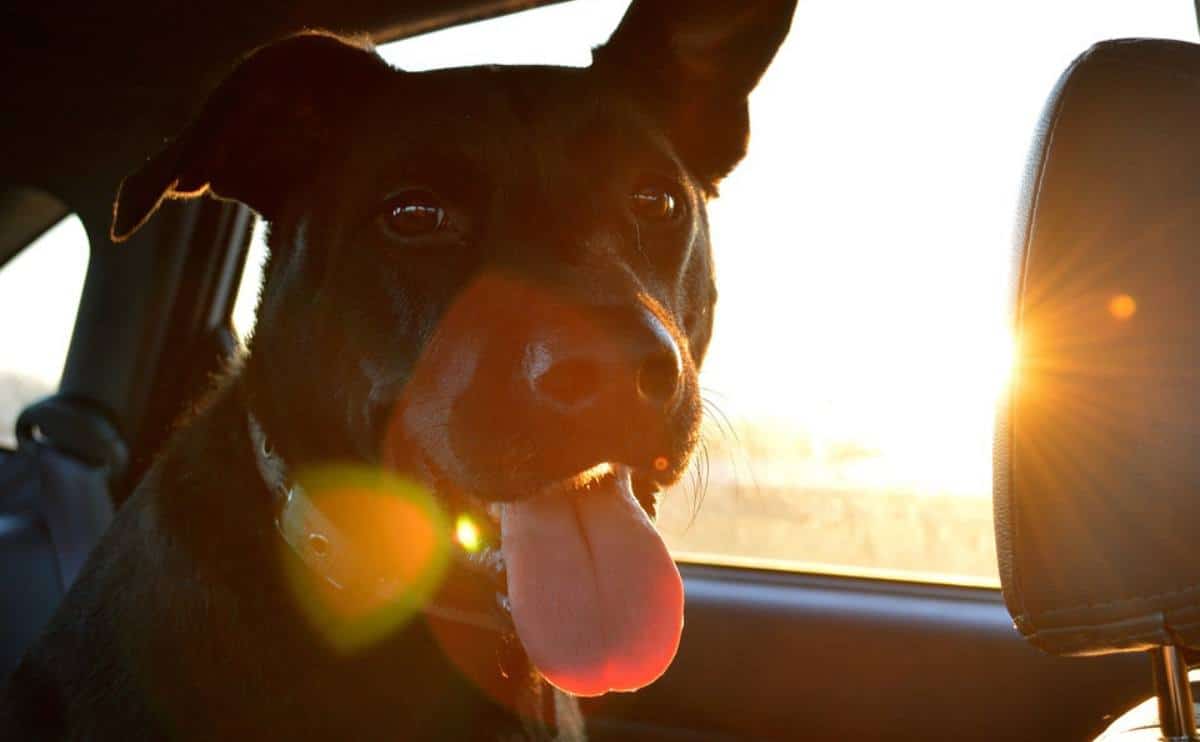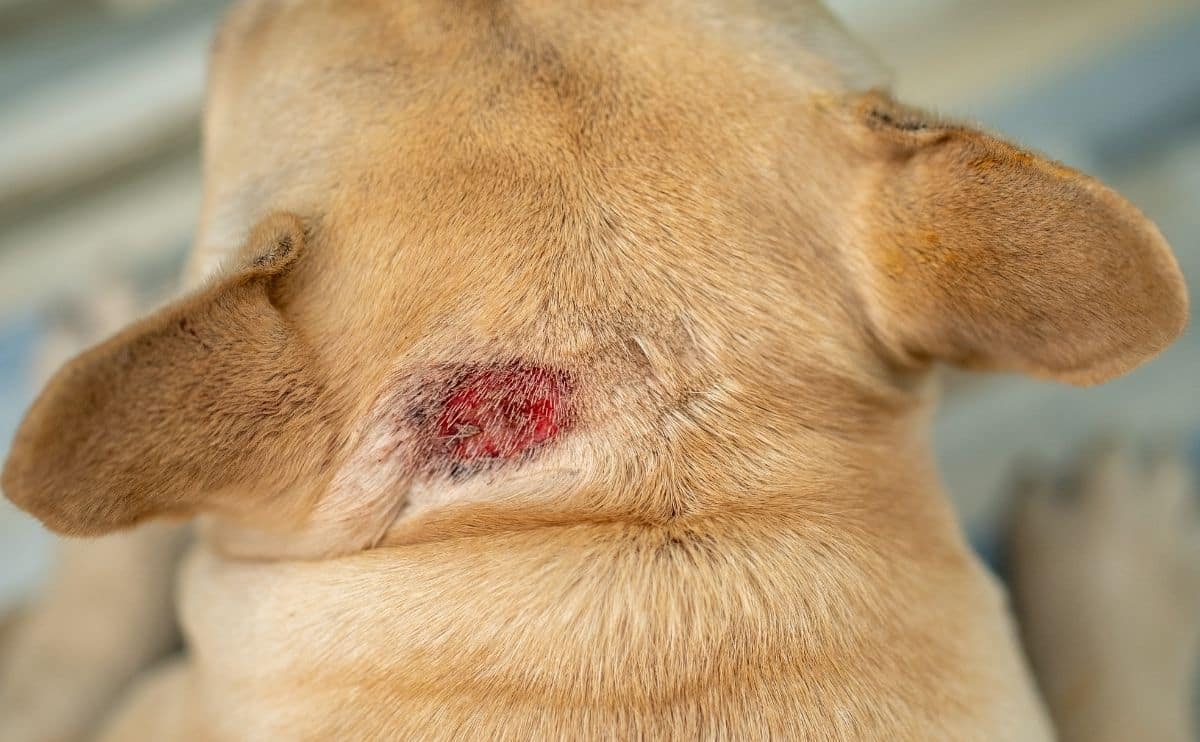Torn ACL In Dogs: Causes, Symptoms, Treatment & More
When you purchase through links on our site, we may earn a commission. Here’s how it works.
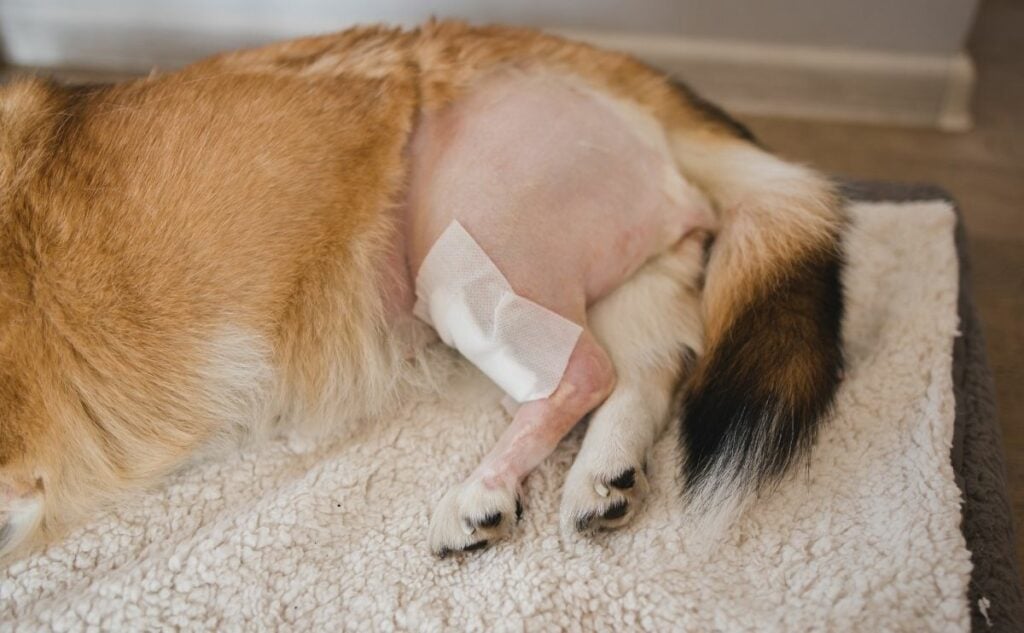
Are you worried your pup might have a torn ACL? The term ACL stands for anterior cruciate ligament, and it is one (of many) things humans and dogs share. Just like humans, ACL tears are some of the most common orthopedic injuries to dogs. Ligaments act like rubber bands that connect our bodies’ bones and help stabilize our legs when we walk, run, change direction, or even stand up or sit down. With the right amount of pressure, ligaments can tear. One of the most serious and common tears occurs in the knees, where the ACL is located.
Table of Contents
ACL tears in dogs are extremely painful, and if they are not treated correctly, they can permanently affect your dog’s ability to run or even walk. Let’s get into the basics and what you need to know if you’re concerned about an ACL tear in your pup.
Facts About ACL Tears In Dogs
The medical name for an ACL tear in dogs is a cranial cruciate ligament (CCL) rupture.
- Statistics show that as much as 85% of all orthopedic injuries in dogs are related to ACL injuries.
- Overweight and unfit dogs are more likely to suffer from these tears.
- Anterior cruciate ligament tears are common causes of arthritis in dogs.
- ACL tears can be partial or complete tears. Treatment is dependent on which type of tear occurred.
- ACLs are only located in the hind legs of dogs.
Causes Of ACL Tears In Dogs
An injury to the CCL can occur in various ways. It can be very sudden, sometimes happening during regular play or a walk. Injury can also occur due to age and the weakening of the joints, leading to a tear. Degenerative joint disease is another condition that can contribute to ACL tears in canines. It can also occur after a sudden trauma, like a fall or landing from a big jump.
ACL tears often occur after a twisted knee, especially in larger breeds and overweight dogs. They can also affect small breeds, especially those susceptible to genetic conditions affecting the joints.
Breeds At Higher Risk Of ACL Injury
Some dog breeds are more prone to ACL injury than others. For some, it is due to genetics, while for others, energy level, activity, and build contribute. The breeds below tend to have more ACL injuries, though it can affect any breed:
- Akita
- Australian Shepherd
- Bichon Frise
- Boxer
- Chesapeake Bay Retriever
- German Shepherd
- Golden Retriever
- Labrador Retriever
- Mastiffs
- Newfoundland
- Rottweiler
- Saint Bernard
- Staffordshire Bull Terrier
Symptoms Of Torn ACL
Symptoms can be mild and often attributed to other things; however, they can worsen quickly. If you suspect a knee injury, keep an eye out for these symptoms and seek vet treatment early. Early treatment means the best possible recovery.
- Limping or tenderness in hind legs.
- Awkward posture when standing or lying down, may have one hind leg sticking out.
- Difficulty getting up from resting position, especially in the mornings.
- Swelling or bruising around the knee joint.
- Stiffness after exercising or resting.
- A clicking sound during walking.
- Low energy or disinterest in regular activities.
- Vocalizing pain, whimpering, whining, etc.
Spotting ACL Tears In Dogs (VIDEO)
For more good information, see the video below from Dr. MIchael Bauer as he discusses how to spot and treat ACL tears in dogs:
Diagnosing CCL Tears In Dogs
Diagnosing an ACL (CCL) in a dog requires a physical exam and imaging, such as X-rays. X-rays also show if there is any fluid buildup in the joint and if there are other injuries or issues in the knee. If a tear is present, your veterinarian will perform a cranial drawer test, where the bones in the leg are felt and shifted to test the severity of the tear. Then, the vet will usually perform a tibial compression test to determine if the tear is minor or major.
Your vet will then diagnose the tear as partial or complete. A partial tear means that the tear impacts a smaller portion of the ligament. A complete tear, also called a rupture, means that the tear spans across the full ligament and needs more intense treatment.
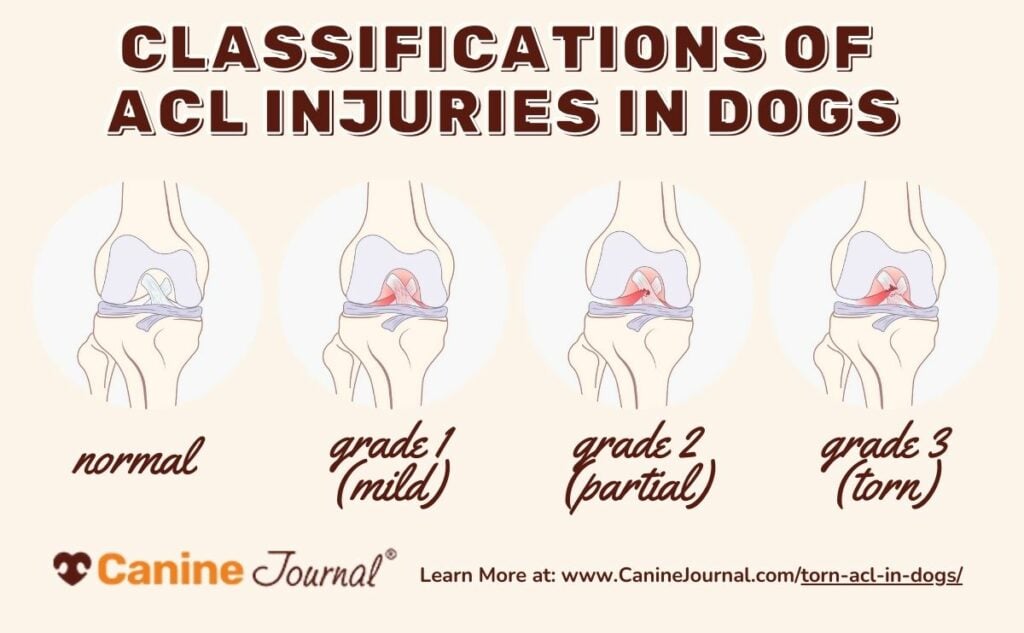
How To Treat Partial Tear Of ACL
A minor or partial ACL tear can be treated in several ways, depending on your dog’s type and size. Surgery is not needed for most relatively healthy dogs, and conservative management can be highly effective for more minor injuries. By managing pain and restricting activity, the injury can heal without intrusive treatment. This is the best-case scenario.
Rest, physical therapy, and healthy bone and joint supplements can be added to your dog’s routine, and they should be feeling better in a matter of weeks.
In some rare cases, like if your dog has a history of joint injuries or if he’s older, surgery might be needed.
How To Treat A Complete Cranial Cruciate Ligament Tear
Complete ACL tears almost always require surgery. For the knee to stabilize and support the weight and daily activities your dog needs, he would have to go under the knife.
There are multiple surgeries that can take place, again, depending on the size and breed of your dog. Surgeries range from slightly evasive to extremely taxing on you and your pet. It can be as simple as a small wire being inserted into the femur to hold the knee in place and as difficult as requiring screws, plates, and many hours on an operating table.
Types Of Canine ACL Surgery
There are several different types of CCL surgery. However, the three most common are TTA, TPLO, and Lateral Surgical Techniques.
1. Lateral Surgical Techniques
These are the most common surgeries for CCL tears in dogs. They use very strong sutures to stabilize the knee. The sutures are placed on the outside of the joint, along with a metal clip if needed. These mimic the natural joint and allow dogs to recover normal function.
2. TTA – Tibial Tuberosity Advancement
TTA stands for Tibial Tuberosity Advancement. It basically means that they cut the shin bone and advance it forward. Once it’s been advanced, they stabilize it by attaching plates to the knee bone and leaving that intact. It’s a procedure that’s worked well for many dogs, especially those that have torn both knee ligaments in their knee.
3. TLPO – Tibial Plateau Leveling Osteotomy
TLPO is a common joint surgery that helps repair CCL tears in dogs, especially larger breeds. The damaged ends of the ligament are removed, and the bone is shaved down. Plates and screws then hold the repaired area together.
Dog ACL Surgery Costs
All surgeries require different procedures, and all have different costs. If you have pet insurance, it may offer a way to offset the price of major ACL surgery. You can expect to pay as much as $1,000 for minor surgeries. One thing to take note of is that many insurance policies have a waiting period for some procedures, and for some, this includes CCL tear surgery. Getting insurance early means your pup has coverage when you need it.
More evasive surgeries can cost up to $6,000, but most range from $2,500 to $4,500, according to TPLO Guide, a great resource for finding additional information about these tears in dogs and how to best treat each specific case.
Pet Insurance Claim Reimbursement
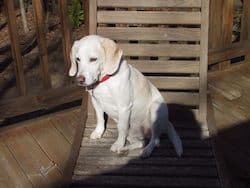
Below is how one pet insurance company handled reimbursement for TPLO surgery due to a ruptured cruciate ligament in the dog’s right rear leg.
- Dog: Jed, 6-year-old Labrador Retriever
- Diagnosis: Torn cruciate ligament
- Total Vet Cost: $4,751.15
- Plan Details: $200 deductible (per condition, annually); 90% reimbursement
- Total Reimbursed By Fetch: $3,296.74
Recovery Timeline
The recovery period for dogs with ACL injuries ranges from several weeks to six months or longer. It depends on whether they had surgery, the type of surgery, and the severity of the injury.
After surgery, your pup may need a cone or Elizabethan collar to prevent licking at the surgery site. For the first few weeks, your pup should have limited movement and avoid physical play with other dogs. They should only go outside on a handheld leash, with a lift harness to support the back legs at all times.
At about three or four weeks, the Elizabethian collar can be removed, and you can start taking your pup for very short walks once a day. Avoid rigorous play, and keep your dog on a leash even when out in the backyard.
Around six weeks after surgery, your pup can start having a few minutes off-leash in the backyard. Gradually increase this as recovery progresses. The process will vary; some dogs can return to regular activity after two or three months, but others need longer.
Consider rehabilitation and physical therapy to help your dog recover and regain as much use of the joint as possible.
Frequently Asked Questions
There are plenty of questions about treating ACL tears in dogs. I’ve answered a few below; please let me know in the comments if I didn’t get to yours. If you have a dog that has recovered from an ACL tear, I’d love to hear your experience as well.
How Can I Prevent My Dog From Getting An ACL Tear?
Ultimately, there is no sure-fire way to prevent your dog from tearing his ACL. Dogs will be dogs, and you can’t ask him not to have his natural instincts to chase squirrels or change direction when you’re playing together. You can make sure that both of you are protected by looking into pet insurance and monitoring his behavior if you feel something is off.
Don’t hesitate to call your veterinarian if your dog favors his back leg. Do your due diligence by checking for swelling or tenderness. If you think your dog might need surgery, consult your vet and discuss your options so that you give your dog the best possible chance for recovery.
Is A Dog In Constant Pain With An ACL Tear?
It can be hard to say because dogs cannot tell us how much something hurts, but it is safe to assume that they are in pain if they are not walking normally, limping, and having trouble getting comfortable when resting.
Can An Older Dog Have ACL Surgery?
Older dogs can have this surgery; it all depends on your pup, vet, chance of recovery, and budget. While age is a factor, overall health plays a role as well. It’s best to discuss your pup’s specific health issues with your vet to determine the best plan forward.
Keeping Your Dog Comfortable
Relocating from an injury takes time, and keeping your pup comfortable and entertained can be challenging. This is compounded when they must have restricted physical activity. There are several ways you can help. Learn more about laser therapy and hydrotherapy for dogs. Dog massage therapy may also help, and you can look into CBD oil and CBD dog treats for help with pain management and mood.
Why Trust Canine Journal?
Danielle is a researcher and dog owner with over thirty years of experience caring for dogs. She has raised several rescue pets, including those with special medical needs, such as epilepsy, heart disease, and dementia. Her research focuses on canine health, care, and behavior. Danielle is part of a dedicated team at Canine Journal that strives to bring our readers the best canine information to better their lives.

